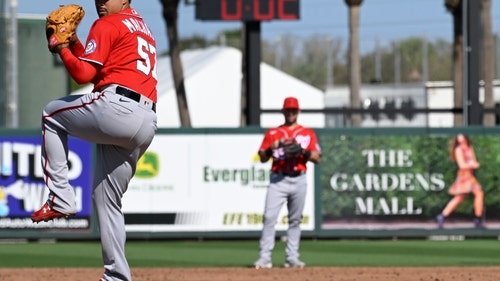
Is game due for rule change to cut down on too many K's?

If you’ve been reading my ramblings for more than a few months, you might have read enough already about my fundamental dislike of Three True Outcomes baseball; if so, please feel free to skip to the last graf, where you might find something new.
But I’ve been here at FOX for only a few weeks! You might never have heard of me before now! Which gives me license to ... Well, I’m not exactly going to repeat myself. But I do return to some subjects, the ones I really care about, again and again.
And I really care about the Strikeout Scourge. Every year there are more strikeouts than the year before, and there is absolutely no hint of this trend stopping or even slowing. I love the game but I’m sick of the strikeouts. And so is Frank Deford:
It's time to make home plate smaller. I know: That's heresy; that's sacrilegious. But there are simply too many strikeouts in baseball now, and that hurts the game, because if the ball isn't in play, it's boring.
The size of home plate was not decreed by God. Back when it was an iron plate — where the name came from — it was, in fact, round. It became rubber and a square, 12 inches to a side, but its present distinctive shape was established in 1900 — a full 17 inches across.
That's too broad for the pitchers today, especially when so many strikes are on the corners, or even "on the black," the small fringe that frames the plate. If you cut, say, an inch and a half off each side, pitchers would have a 14-inch target. Batters would have a more reasonable chance to try to connect. They'd swing more, put more balls in play. It'd be more fun, a better game both to play and to watch.
First, I’m thrilled that Deford is actually thinking about baseball in the same way that I do. More balls in play would make for a better game, both to play and to watch. This strikes me as so elementary that I’m actually surprised, just a little bit, that Commissioner Bud, with all his God-given powers, hasn’t made even the smallest effort to address the Scourge.
I’m also surprised, just a little bit, that Deford so easily settles on this particular solution. Because there are others, no more problematic and perhaps more effective. Making home plate smaller — or making the strike zone smaller in some other fashion — probably would mean fewer strikeouts ... but it might mean more walks, too.
And I’m not sure there’s any point in trading one True Outcome for another that, by the way, is even less interesting than the average strikeout. I mean, nobody pays to see a base on balls.
Are there other things that might be tried? Sure. Here’s Dan Brooks, writing in the latest (print!) edition of Baseball Prospectus:
If we’ve accepted that we want to change the game to minimize the TTOs, we’re admitting that the strategies teams use to win are undesirable. Proposed solutions exist: deadening the ball (to reduce home run rates), shrinking the strike zone (to reduce strikeout rates, though at the cost of increased walk rates) or lowering the mound (presumably to lower strikeout rates). All of these proposed solutions to the game — which I think are the only ones we should seriously consider — would not fundamentally alter the rules, but adjust them at the margins. Although more dramatic solutions could certainly be proposed, most would strain credulity.
I met Dan last night, actually ... and forgot to ask about these “more dramatic solutions,” but I know about just one: Bill James has been suggesting for some years that the bats be more strictly regulated.
Basically, Bill suggests that if the bats were thicker and heavier, players would be discouraged from swinging so hard every time. Which would mean fewer strikeouts (and yes, home runs). Like the olden days, when guys like Joe DiMaggio and Ted Kluszewski somehow finished seasons with more home runs than strikeouts.
Well, maybe. I’m not saying Bill’s wrong. But pitchers today throw a lot harder than they did in Big Klu’s era. I worry that most hitters just wouldn’t have a chance against pitchers throwing 95 if they couldn’t swing the bat so hard.
I also wonder why, if using bigger bats and swinging slower is really a winning strategy, at least for some hitters, nobody’s actually doing it. What I think is that pitchers just throw too damned hard for the old ways to work.
Which is why I would start with the pitchers. I think you simply have to start with the pitchers. Physically, you’re not going to slow them down; in fact they’re just getting faster. While there might be a natural limit — maybe it’s practically impossible to throw 110 miles an hour — we know that more and more pitchers are hitting 100 when that figure was once extraordinarily rare.
But if you can’t put a governor on the pitchers themselves, you can change their workplace. So the first thing I would do is lower the mound. An inch, two inches ... I don’t know. The impact of such a change could be estimated theoretically with little trouble, and measured experimentally with just a bit more trouble (more on that later).
But I wouldn’t stop there. In isolation, lowering the mound would almost certainly help the hitters. But we’re not trying to help the hitters. We’re trying to maintain an attractive balance between the pitchers and hitters, and between Three True Outcomes and balls in play.
Which is why I would certainly recommend deadening the baseball just a bit, too. Deadening the ball would balance the drop in strikeouts and it would encourage pitchers to throw strikes, which presumably would lead to fewer walks, too.
All that sounds great, right?
Not to Brooks:
The sabermetric revolution is just beginning, not ending. The metagame is far from solved. Baseball roster construction is a game with an extraordinarily high skill ceiling. It takes exceptional dedication and brilliance to do it right. We’re probably not very close to finding the best strategies yet, and the search is fun. We should let it play out for a few more rounds before we upset the balance.
How many more rounds? While I won’t argue that the metagame is solved, it does seem that everyone’s just sort of been fooling around at the margins for a while. Actually, with one exception, the only things that are really changing are the strikeouts and the pitching changes, with more of both.
Walks and home runs are, given normal fluctuations, pretty stable. The one exception is the new emphasis on defensive shifts. We’ll see more of that, at least until enough hitters actually try to beat the shifts. That might actually slow down the Strikeout Scourge, at least temporarily. But that would, I suspect, merely lead to slightly fewer shifts and the strikeouts would go proceed apace.
No, I think Brooks’ faith in the balance is misguided. The game has become unbalanced and shows no signs of a self-correction without some help. Every so often, the game needs some help.
I actually think that most people who actually think about these things with any rigor might agree. But those people don’t include, I’m sorry to say, the players who would need to approve any real changes.
I’m sure the hitters would love to see the mound lowered, and pitchers would love to see the ball deadened. But good luck getting them to agree on both. You can’t really blame them. Change is terrifying, especially when one’s livelihood is involved.
At best, you’ll have to make a good case to the players why change is necessary and what it would actually look like. And the best way to do that is experimentally.
As I’ve written before, Major League Baseball should purchase at least a piece of a relatively high-level independent league — the Atlantic League, ideally — and subsidize the franchises while using the schedule as a test bed for any number of new procedures.
Because it’s one thing for Dan Brooks and Rob Neyer and Bill James to sit around and theorize. And yes, we do have history with different bats and different mound heights and different strike zones and different baseballs.
Smart people could do plenty of interesting things with that history. But history’s not going to convince the Players Association. These guys are going to want something from the 21st Century, and so far we don’t have anything for them except a bunch of opinions from guys born in the middle of the 20th.










